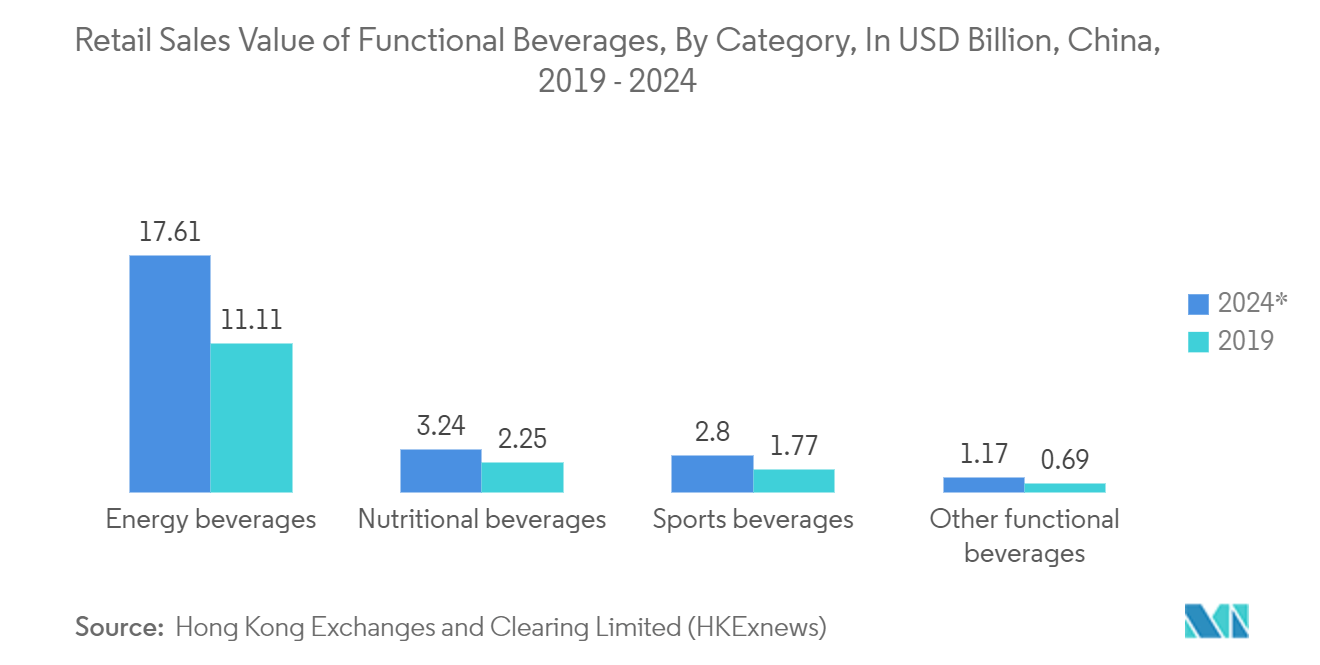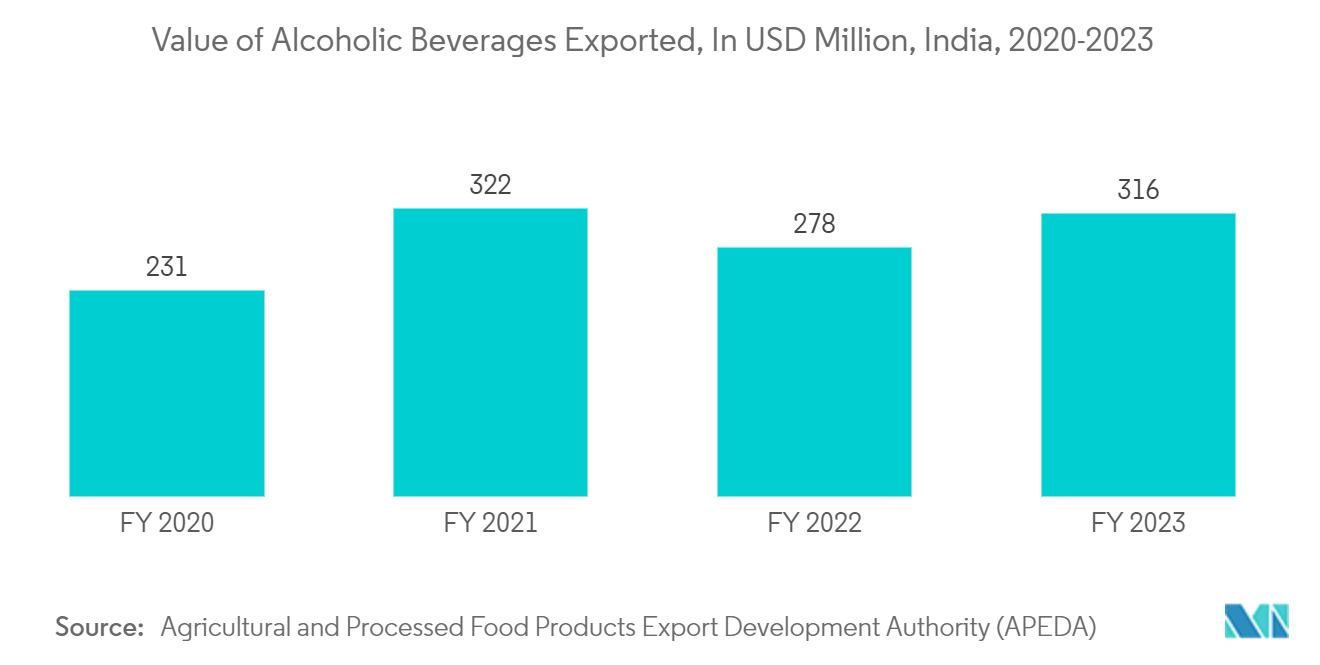Market Trends of Asia-Pacific Glass Bottles And Containers Industry
Beverage Occupies the Largest Market Share
- The beverage industry’s dominance, accounting for approximately 60% of the market share in the Asia-Pacific container glass market, plays a pivotal role in driving the market's growth.
- Consumers are increasingly aware of the health benefits of using glass over plastic, particularly for beverages. Glass is non-toxic, does not leach chemicals into the product, and is considered safer for long-term use, especially in alcoholic beverages. This shift in consumer preference is expected to fuel growth in the container glass market.
- China's packaging industry is experiencing rapid and steady growth, fueled by the country's expanding economy and a growing middle class with increased purchasing power. The beverage market's expansion is driving a heightened demand for packaging, particularly in the glass container segment. While each beverage category presents unique challenges and opportunities, emerging trends in Chinese consumer lifestyles are shaping the demand for glass packaging.
- China's major urban areas have witnessed an increase in the consumption of both alcoholic and non-alcoholic beverages. Alcoholic beverages, with roots in ancient times, include rice wine, grape wine, beer, whiskey, and various spirits. Baijiu remains the most consumed distilled spirit in China.
- According to HKEXnews, in 2021, Nongxiang flavor baijiu generated revenue of approximately CNY 286 billion (USD 40.42 billion), accounting for over half of China's baijiu sales revenue. The revenue from Nongxiang flavor baijiu is projected to reach CNY 312.9 billion (USD 44.22 billion) by 2026.
- Korean drinking culture extends beyond alcohol consumption to include traditional accompanying foods. Korean cuisine, known for its intense and spicy flavors, often complements alcohol consumption. From traditional rice wines to the increasingly popular soju, alcohol plays a central role in Korean society and culture. The market is predominantly characterized by low-priced brands producing soju for mass consumption.
- Glass packaging offers several advantages for beverage storage. It is sustainable, infinitely recyclable, reusable, refillable, and inert, containing no synthetic chemicals. These properties make glass a viable option for packaging beverages safely.
- Coca-Cola Japan has implemented various sustainability initiatives, including removing plastic labels from drinks and reducing power consumption in vending machines. This aligns with the company's global commitment to recycle 25% of packaging worldwide by 2030 and implement reusable packaging, including glass bottles. Such initiatives are contributing to the growth of the glass container market in the region.
- Increasing health and wellness awareness among consumers is driving demand for functional beverages, which are perceived to offer various health benefits. Glass packaging aligns with this trend as it is considered a safe and hygienic option for preserving the nutritional integrity of beverages, thus supporting the growth of the glass containers market.
- According to Hong Kong Exchanges and Clearing Limited, the retail sales of functional beverages in China reached nearly USD 15.82 billion in 2019 and are projected to reach USD 24.82 billion by 2024.

India to Account for Significant Market Growth
- The increasing demand for dairy products is driving innovation in glass packaging design. Manufacturers are likely to invest in research and development to create glass bottles and containers that offer improved convenience, durability, and aesthetic appeal. This innovation is expected to contribute to the growth of the Asia-Pacific glass packaging market.
- The dairy industry's focus on sustainability and eco-friendly packaging solutions further propels the adoption of glass containers, as they are recyclable and can be reused multiple times.
- India's dominant position in global milk production further supports this trend. According to Invest India, the country leads worldwide milk production, contributing 25% of the global output. India's milk production increased by 58% between 2014-15 and 2022-23, reaching 230.58 million tonnes in 2022-23. This significant growth in milk production has led to an increased demand for high-quality packaging solutions, with glass bottles being a preferred choice for premium dairy products.
- Soft drink manufacturers are actively promoting the use of glass bottles. In March 2023, Coca-Cola India's Thumbs Up launched a television campaign, 'Toofan Glass Mein Nahin, Glass Se Peete Hain,' encouraging consumers to experience the beverage from returnable glass bottles. The company aims to sell at least 25% of its beverages globally in reusable or returnable containers by 2030, including drinks sold at soda fountains and in glass bottles.
- This initiative not only promotes sustainability but also enhances the consumer experience, as glass bottles are known to maintain the beverage's carbonation and flavor better than other packaging materials.
- The growth in non-alcoholic beverages, particularly soft drinks, is also expected to impact the market demand for glass packaging. The rising health consciousness among consumers has led to an increase in the consumption of natural and organic beverages, which are often packaged in glass bottles to maintain their purity and freshness. Additionally, the premium segment of non-alcoholic beverages, including craft sodas and artisanal drinks, often opts for glass packaging to convey a sense of quality and luxury.
- Increased exports of alcoholic beverages are driving demand for glass bottles and containers. Glass packaging is preferred for alcoholic beverages due to its ability to preserve flavor and quality. According to APEDA, in the financial year 2023, India's export value of alcoholic beverages reached USD 316 million, an increase of USD 38 million from the previous year.
- This growth in exports has led to a higher demand for premium glass packaging, as international markets often have stringent quality and packaging requirements for imported alcoholic beverages. Furthermore, the rise of craft breweries and distilleries in the region has created a niche market for specialized glass bottles and containers, further driving the growth of the glass packaging industry.


